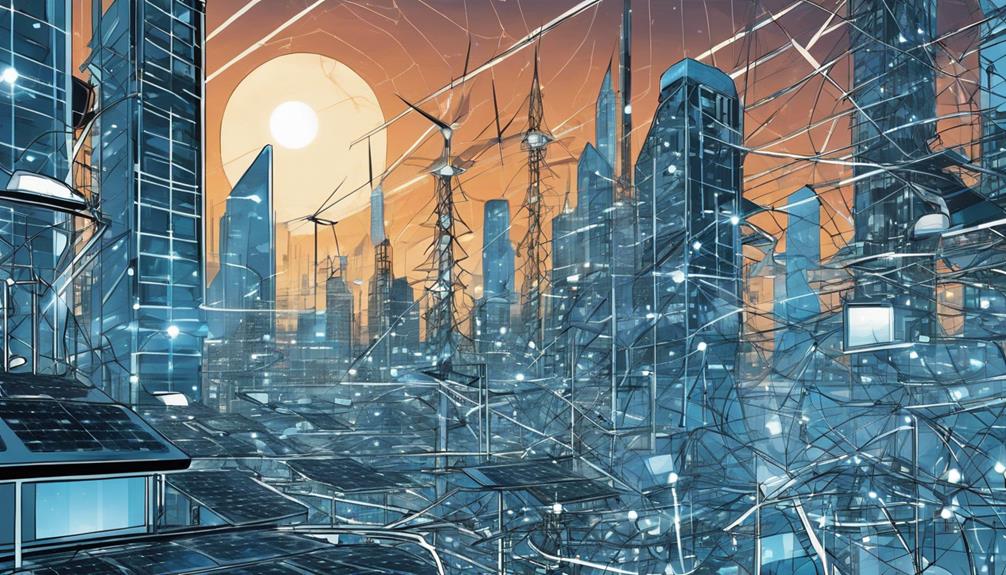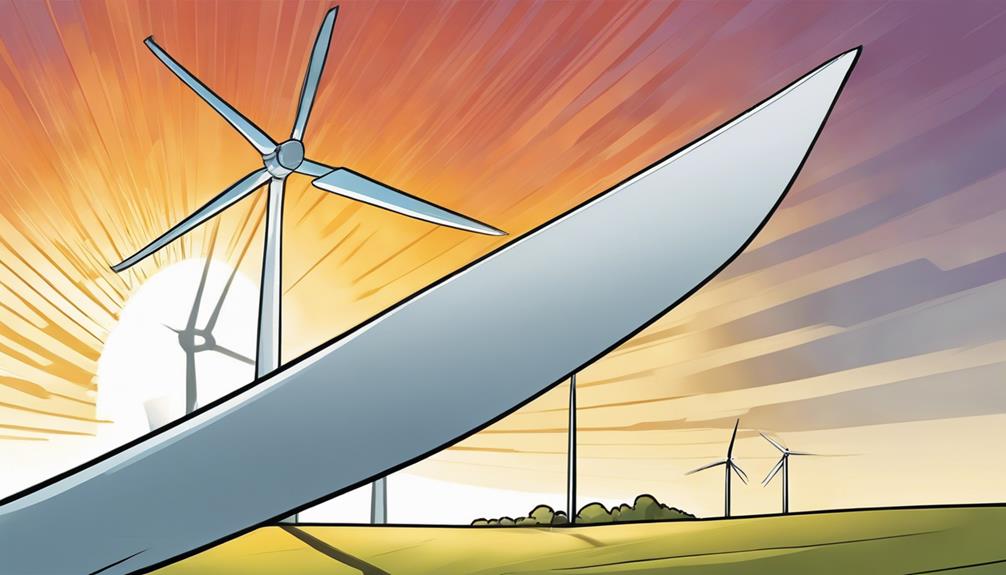You're on the cusp of a smart energy revolution! AI-driven smart grids are transforming energy distribution, making it more efficient, reliable, and sustainable. AI optimizes energy distribution through data analysis and predictive capabilities, accurately forecasting energy demand and adapting to changes in renewable energy availability. It also enables predictive maintenance, dynamic load balancing, and efficient energy allocation. As you explore the intersection of smart grids and AI, you'll uncover the secrets to a more personalized, efficient, and greener energy future – and that's just the beginning of what's in store.
Key Takeaways
- AI optimizes energy distribution through data analysis and predictive capabilities, ensuring efficient energy allocation.
- Smart grid technology integrates energy distribution and digital communication, enabling seamless data exchange and efficient management.
- AI accurately forecasts energy demand based on energy usage and weather forecasts, allowing for proactive resource allocation.
- Predictive analytics and real-time monitoring enable efficient load balancing, reducing strain on the grid and promoting sustainability.
- AI-driven energy management systems offer personalized energy usage insights, promoting a greener energy future and efficient energy distribution.
AI Enhancements in Energy Distribution
As you delve into the realm of smart grids, you'll discover that AI plays a crucial role in optimizing energy distribution, utilizing data analysis and predictive capabilities to ensure a more effective and dependable flow of electricity.
By examining energy usage and weather forecasts, AI accurately forecasts energy demand, enabling optimized energy distribution that minimizes waste and enhances efficiency.
In addition, AI dynamically adapts to changes in renewable energy availability, improving grid operations and ensuring a seamless flow of electricity.
With predictive analytics, AI aids in predicting equipment failures, facilitating proactive maintenance that lowers operational costs and reduces downtime. This leads to improved dependability, decreased operational expenses, and enhanced overall energy management.
As AI progresses in smart grids, you can anticipate even more substantial enhancements in energy distribution. By harnessing the capabilities of AI, smart grids can become even more efficient, reliable, and sustainable, paving the way for a brighter energy future. Advancements in AI technology can also lead to the development of more resilient solar power solutions, which can help mitigate disruptions in energy supply caused by natural disasters or other unforeseen events. By integrating AI into smart grid systems, utilities and energy providers can better manage the fluctuations in supply and demand for solar energy, ultimately leading to a more stable and reliable energy infrastructure. This will ultimately contribute to a more sustainable and environmentally friendly energy future for generations to come.
Smart Grid Technology Integration

Your smart grid experience begins with the integration of energy distribution and digital communication, which enables efficient management of electricity generation and transmission.
This integration allows for the seamless exchange of data from energy producers to consumers, creating a dynamic energy system.
With AI in Smart Grid, you can optimize power allocation, cost, and generation strategies, ensuring that energy production meets demand efficiently.
The integration of renewable energy generation into the grid is also made possible, enabling a more sustainable energy future.
Predictive analytics plays an essential role in this integration, helping to forecast high-demand strains and balance loads efficiently. This enhances overall grid performance and reliability.
Additionally, smart grid technologies enable IoT sensors to detect risks, aid in self-repair, and provide better control of the grid.
As a result, you'll experience a more responsive and resilient energy system.
With multidirectional energy flow and customer choice, you'll have more control over your energy usage, promoting a more dynamic and efficient energy system.
Renewable Energy and Big Data

You can tap into the vast potential of renewable energy sources like solar and wind by harnessing the power of Big Data analytics to optimize their integration in smart grids.
By leveraging Big Data techniques, you can analyze the vast amounts of data generated by these sources to better understand their generation patterns. This enables you to optimize energy distribution efficiency, ensuring a stable and reliable energy supply.
Big Data analytics also helps you predict renewable energy output, allowing you to optimize grid operations and reduce the overall carbon footprint in the energy sector.
With real-time monitoring capabilities, you can efficiently allocate resources and make strategic decisions for sustainable energy distribution.
By integrating Big Data into renewable energy management, you can unleash the full potential of smart grids, enabling a more efficient, reliable, and environmentally friendly energy distribution system.
Applications of AI in Energy

As you explore the applications of AI in energy, you'll discover how it's transforming the industry. AI is revolutionizing energy management by predicting high-demand strains and balancing loads efficiently, anticipating equipment failures, and dynamically adjusting to changes in renewable energy availability. By analyzing data from energy usage and weather forecasts, AI optimizes energy distribution, reducing waste and enhancing reliability.
Here are some key applications of AI in energy:
| Application | Description |
|---|---|
| Predictive Maintenance | Anticipates equipment failures, reducing downtime and optimizing energy distribution |
| Load Balancing | Balances energy loads efficiently, reducing strain on the grid during peak times |
| Renewable Energy Integration | Dynamically adjusts to changes in renewable energy availability, ensuring a stable energy supply |
| Energy Efficiency | Improves energy efficiency through predictive analytics, reducing energy waste and supporting sustainable energy sources |
| Grid Operations | Enhances grid operations, optimizing power generation strategies and improving overall efficiency |
Future of Energy Management Systems

Building on the transformative impact of AI in energy, the next generation of energy management systems is poised to revolutionize the way power is distributed and consumed, leveraging advanced technologies to create a more sustainable and efficient energy ecosystem.
As you look to the future, you'll see energy management systems relying heavily on AI to optimize power distribution and integrate renewable energy sources efficiently. With AI technologies, you'll benefit from real-time monitoring, predictive maintenance, and dynamic load balancing, ensuring a more reliable grid. These smart systems will anticipate energy demand, reducing wastage and lowering operational costs for utilities.
The future of energy management systems also includes advanced analytics, IoT integration, and smart algorithms to enable a more sustainable and resilient grid. With AI-driven energy management systems, you'll receive personalized energy usage insights, promoting energy conservation and supporting the shift to a greener energy future.
Get ready to experience a more efficient, sustainable, and personalized energy ecosystem.
Frequently Asked Questions
What Is the Role of AI in the Smart Grid?
You're wondering what AI does in a smart grid. Well, it's the brain that optimizes energy distribution by forecasting high-demand strains, balancing loads, and enabling proactive decision-making based on various grid variables, ensuring efficient and reliable energy supply.
How Does a Smart Grid Make Energy Use More Efficient?
You flip the switch, and the lights come alive, but have you ever wondered how a smart grid makes energy use more efficient? It's like a maestro conducting an orchestra, dynamically adjusting to changes in demand and supply, harmonizing energy distribution to reduce waste and costs.
What Is the Role of Smart Grid in Renewable Energy?
You're wondering what role smart grids play in renewable energy. Simply put, they enable efficient integration of solar and wind power into the grid, balancing supply and demand in real-time, reducing dependence on fossil fuels.
What Are the Four Main Benefits of Smart Grids?
You're stuck in the dark ages of energy distribution, but smart grids are the bright light of hope. They offer four main benefits: reduced transmission losses, enhanced reliability, better renewable integration, and empowered consumers.
Conclusion
As you flip the switch, a symphony of innovation unfolds. The hum of the grid, once a cacophony of inefficiency, now harmonizes with the rhythm of AI.
Renewable energy sources sing in perfect pitch, their data harmonies orchestrated by smart grid technology.
The future of energy management systems unfolds like a canvas of endless possibility, where the brushstrokes of innovation paint a vibrant picture of sustainability and efficiency.
You're the conductor, orchestrating a brighter tomorrow, one smart decision at a time.









